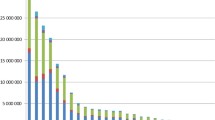Abstract
Objectives: To model the economic impact of introducing an occupational vaccination programme for influenza with an inactivated influenza subunit vaccine (Influvac®) in the UK.
Design and setting: Using published sources, a decision tree was constructed which modelled the costs and benefits of introducing an influenza vaccine in a business in the UK from the perspective of an employer.
Study participants and interventions: The model considered the implementation of an occupational vaccination programme with Influvac® in a business employing 1000 normal healthy adults earning the national average wage in the UK. The model assumed that 95% of employees would be absent from work after contracting influenza for a mean of 5 days and that the level of productivity would be reduced by 60% for one day by 85% of sick employees returning to work.
Main outcome measures and results: The expected probability of an employee being absent from work following an influenza vaccination would be reduced from 5.7 to 1.8% when the incidence of influenza in the community is 6%.Accordingly, if all 1000 employees were vaccinated, a business would be expected to reduce absenteeism from work attributable to an influenza outbreak by 220 days. Moreover, the expected return on every pound invested by an employer would be £1.03, £3.09 and £5.15 (2000 values) when the annual incidence of influenza in the community is 2, 6 and 10%, respectively.
Conclusions: Implementation of an occupational vaccination programme with Influvac® would be expected to reduce the incidence of influenza among a workforce leading to less absenteeism from work and averted lost productivity. Even if the incidence of influenza was as low as 2% it may be a worthwhile investment for UK employers to vaccinate their employees with Influvac®.





Similar content being viewed by others
References
Couch RB. Advances in influenza virus vaccine research. Ann N Y Acad Sci 1993; 685: 803–12
Fleming DM. The contribution of influenza to combined acute respiratory infections, hospital admissions and deaths in winter. Commun Dis Public Health 2000; 3 (1): 32–8
Immunisation against infectious disease (green book). Norwich: The Stationary Office, 1996: 113–20
Ashley J, Smith T, Dunnell K. Deaths in Great Britain associated with influenza epidemic of 1989/90: population trends. OPCS. London. HM Stationary Office 1991; 65: 16–20
Levy E. French economic evaluations of influenza and influenza vaccination. Pharmacoeconomics 1996; Suppl. 3: 62–6
Szucs TD. Influenza: the role of burden-of-illness research. Pharmacoeconomics 1999; 16 Suppl. 1: 27–32
Postma MJ, Bos JM, van Gennep M, et al. Economic evaluation of influenza vaccination: assessment for the Netherlands. Pharmacoeconomics 1999; 16 Suppl. 1: 33–40
Fedson DS. Evaluating the impact of influenza vaccination: a North American perspective. Pharmacoeconomics 1996; 9 Suppl. 3: 54–61
Guest JF, Morris A. Community-acquired lower respiratory tract infections: the annual cost to the National Health Service. Br J Med Econ 1996; 10: 263–73
NHS Lung and Asthma Information Agency. Sickness absence from respiratory disease. London: Department of Public Health Sciences, St George’s Hospital Medical School, 1992
Govaert TME, Thijs CT, Masurel N, et al. The efficacy of influenza vaccination in elderly individuals: a randomised double- blind placebo-controlled trial. JAMA 1994; 272: 1661–5
Gross PA, Hermogenes AW, Sacks HS, et al. The efficacy of influenza vaccination in elderly persons: a meta-analysis and review of the literature. Ann Intern Med 1995; 123: 519–27
Ahmed H, Nicholson K, Nguyen-Van-Tam J. Reduction in mortality associated with influenza vaccine during 1989-90 epidemic. Lancet 1995; 346: 591–5
Ambrosch F, Fedson DS. Influenza vaccination in 29 countries: an update to 1997. Pharmacoeconomics 1999; 16 (1): 47–54
Palache AM. Influenza immunisation. J Clin Res 1999; 2: 111–32
Fleming DM, Watson JM, Nicholas S, et al. Study of the effectiveness of influenza vaccination in the elderly in the epidemic of 1989/90 using a general practice database. Epidemiol Infect 1995; 115: 581–9
Nichol KL, Margolis KL, Wuorenma J, et al. The efficacy and cost effectiveness of vaccination against influenza among elderly people living in the community. N Engl J Med 1994; 22: 778–84
Hak E, van Essen GA, Buskens E, et al. Is immunising all patients with chronic lung disease in the community against influenza cost effective?. Evidence from a general practice based clinical prospective cohort study in Utrecht, the Netherlands. J Epidemiol Community Health 1998; 52: 120–5
Campbell DS, Rumley MH. Cost-effectiveness of the influenza vaccine in a healthy, working age population. J Occup Environ Med 1997; 39 (5): 408–14
Fleming D, Charlton J, McCormick A. The population at risk in relation to influenza immunisation policy in England and Wales. Health Trends 1997; 29 (2): 42–7
Buxton Bridges C, Thompson WM, Meltzer MI, et al. Effectiveness and cost-benefit of influenza vaccination of healthy working adults: a randomised controlled trial. JAMA. 2000; 284 (13): 1655–63
Office for National Statistics. Quarterly projections of the New Earnings Survey. Labour market trends. Norwich: The Stationary Office, 2000 Jun
Kumpulainen V, Makela M. Influenza vaccination among healthy employees: a cost-benefit analysis. Scand J Infect Dis 1997; 29 (2): 181–5
Keech M, Scott AJ, Ryan PJ. The impact of influenza and influenza-like illness on productivity and healthcare resource utilization in a working population. OccupMed (Lond) 1998; 48 (2): 85–90
Demicheli V, Rivetti D, Deeks JJ, et al. Vaccines for preventing influenza in healthy adults (Cochrane Review). Available in The Cochrane Library [database on disk and CD ROM]. Updated quarterly. The Cochrane Collaboration; issue 3, 2000. Oxford: Update Software, 1997
Drummond MF, O’Brien BJ, Stoddart GL, et al. Cost benefit analysis. In: Drummond MF, O’Brien B, Torrance GW, et al. Methods for the economic evaluation of health care programmes. Oxford: Oxford University Press, 1998: 205–31
Fleming DM, Ayres JG. Diagnosis and patterns of incidence of influenza, influenza-like illness and the common cold in general practice. J R Coll Gen Pract 1988; 38: 159–62
Sullivan KM. Health impact of influenza in the United States. Pharmacoeconomics 1996; 9 Suppl. 3: 26–33
Glezen WP. Serious morbidity and mortality associated with influenza epidemics. Epidemiol Rev 1982; 4: 25–44
Wilde JA, McMillan JA, Serwint J, et al. Effectiveness of influenza vaccine in healthcare professionals. A randomised trial. JAMA 1999; 281 (10): 908–13
Koopmanschap MA, Rutten FH. Indirect costs in economic studies: confronting the confusion. Pharmacoeconomics 1993; 4 (6): 446–54
de Koning J, Tuyl FA. The relation between labour time, production and employment. Rotterdam: Netherlands Economic Institute, 1984
Annual earnings survey 1997. London: The Stationary Office, 1997
Nichol KL, Lind A, Margolis KL, et al. The effectiveness of vaccination against influenza in healthy, working adults. N Engl J Med 1995; 33: 889–93
Campbell DS, Rumley MH. Cost-effectiveness of the influenza vaccine in a healthy, working-age population. J Occup Environ Med 1997; 39 (5): 408–14
Levy E. French economic evaluations of influenza and influenza vaccination. Pharmacoeconomics 1996; 9 (3): 62–6
Burckel E, Ashraf T, Galvao de Sousa Filho JP, et al. Economic impact of providing workplace influenza vaccination: a model and case study application at a Brazilian pharma-chemical company. Pharmacoeconomics 1999; 16: 563–76
Yassi A, Kettner J, Hammond G, et al. Effectiveness and cost-benefit of an influenza vaccination program for healthcare workers. Can J Infect Dis 1991; 2: 101–8
Acknowledgements
The authors thank Bram Palache and James Piercy for their contributions to the study and Solvay Pharmaceuticals, Weesp for their financial support. The authors have no conflicts of interest with the content of this manuscript.
Author information
Authors and Affiliations
Corresponding author
Additional information
Use of the tradename is for product identification purposes only and does not imply endorsement.
Rights and permissions
About this article
Cite this article
Das Gupta, R., Guest, J.F. A Model to Estimate the Cost Benefit of an Occupational Vaccination Programme for Influenza with Influvac® in the UK. Pharmacoeconomics 20, 475–484 (2002). https://doi.org/10.2165/00019053-200220070-00005
Published:
Issue Date:
DOI: https://doi.org/10.2165/00019053-200220070-00005




